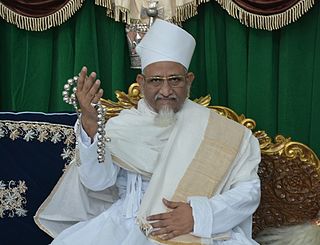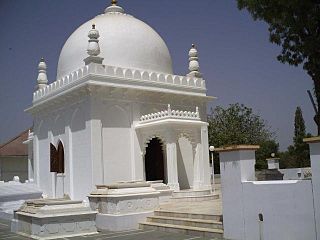
Isma'ilism is a branch or sect of Shia Islam. The Isma'ili get their name from their acceptance of Imam Isma'il ibn Jafar as the appointed spiritual successor (imām) to Ja'far al-Sadiq, wherein they differ from the Twelver Shia, who accept Musa al-Kadhim, the younger brother of Isma'il, as the true Imām.
The Musta‘lī are a branch of Isma'ilism named for their acceptance of al-Musta'li as the legitimate nineteenth Fatimid caliph and legitimate successor to his father, al-Mustansir Billah. In contrast, the Nizari—the other living branch of Ismailism, presently led by Aga Khan IV—believe the nineteenth caliph was al-Musta'li's elder brother, Nizar. Isma'ilism is a branch of Shia Islam.

Abū Tamīm Maʿad al-Mustanṣir biʾllāh was the eighth Fatimid Caliph from 1036 until 1094. He was one of the longest reigning Muslim rulers. His reign was the twilight of the Fatimid state. The start of his reign saw the continuation of competent administrators running the Fatamid state, overseeing the state's prosperity in the first two decades of al-Mustansir's reign. However, the break out of court infighting between the Turkish and Berber/Sudanese court factions following al-Yazuri's assassination, coinciding with natural disasters in Egypt and the gradual loss of administrative control over Fatamid possessions outside of Egypt, almost resulted in the total collapse of the Fatamid state in the 1060s, before the appointment of the Armenian general Badr al-Jamali, who assumed power as vizier in 1073, and became the de facto dictator of the country under the nominal rule of al-Mustansir.
Tayyibi Isma'ilism is the only surviving sect of the Musta'li branch of Isma'ilism, the other being the extinct Hafizi branch. Followers of Tayyibi Isma'ilism are found in various Bohra communities: Dawoodi, Sulaymani, and Alavi.
Hafizi Isma'ilism was a branch of Musta'li Isma'ilism that emerged as a result of a split in 1132. The Hafizis accepted the Fatimid caliph Abd al-Majid al-Hafiz li-Din Allah and his successors as imams, while the rival Tayyibi branch rejected them as usurpers, favouring the succession of the imamate along the line of al-Hafiz's nephew, al-Tayyib.
Al-Mu'ayyad fid-din Abu Nasr Hibat Allah b. Abi 'Imran Musa b. Da'ud ash-Shirazi was an 11th-century Isma'ili scholar, philosopher-poet, preacher and theologian of Persian origin. He served the Fatimid Caliph-Imām al-Mustansir Billah as a Da'i in varying capacities, eventually attaining the highest rank of Bab al-Abwab "The Gate of Gates" and Da'i al-du'at "Chief Missionary" in the Fatimid Da‘wah. In his theological and philosophical writings he brought the Isma'ili spiritual heritage to its pinnacle.

Da'a'im al-Islam is an Ismaili Shia Islam Muslim book of jurisprudence.

The Alavi Bohras are a Tayyibi Musta'lavi Isma'ili Shi'i Muslim community from Gujarat, India. In India, during the time of the 18th Fatimid Imam Al-Mustansir Billah around 1093 AD in Egypt, the designated learned people (wulaat) who were sent from Yemen by missionaries (du'aat) under the guidance of the imam established a da'wah in Khambhat.

Idris Imad al-Din was the 19th Tayyibi Isma'ili Dāʿī al-Muṭlaq and a major religious and political leader in 15th-century Yemen, as well as a notable theologian and the most important medieval Isma'ili historian. His work is fundamental for the history of the Fatimid Caliphate and the Isma'ili communities in Yemen.

Syedna Haatim Zakiyuddin , is the 45th Saiyedna and Da'i al-Mutlaq of Alavi Bohras and Naa'ib (نائب) representative, vicar, legatee and deputy of the progeny of 21st Fatimid Isma'ili Imam Abul Qaasim at-Taiyeb during the time of his Concealment from Cairo in 528 AH/1132 AD which is called Daur us Satr. He is of the noble rank of Da'i al-Mutlaq or ad-Da'i ul-Mutlaq or Da'i-e-Mutlaq enjoying absolute spiritual and temporal authority under the secreted guidance (تأئید) of the Imam of Time. Anyone who gives him Oath of Allegiance and Covenant on the name of Imam at-Taiyeb, then only he is regarded the member of Alavi Bohra Community. The chief jurist an-No'maan of the Fatimid court of Imam Mo'iz says in his work that, As for the true followers, the members of the Ismaili community, they faithfully take the pledge of allegiance to the Imam.

Ja'far us Sadiq Imaduddin or Jafar us Sadiq Mufaddal Saifuddin, is the eldest son of Mufaddal Saifuddin, the current incumbent of the office of the 53rd Dawoodi Bohra Da'i al-Mutlaq, and the grandson of Mohammed Burhanuddin. He is a poet, scholar and one of the four rectors of Aljamea-tus-Saifiyah.

Abdallah was the first Isma'ili missionary in Gujarat.

Syedi Fakhruddin Shaheed is the 11th-century holy Ismaili, Fatimid, mustaali saint who was first Ismaili martyr, martyred during missionary work among Bhils local tribal in Rajasthan and buried in Galiakot, India. The mausoleum is the most venerated place amongst his followers.

Lisaan ud-Da'wat or Lisaan o Da'wat il Bohra or Lisan ud-Dawat is the language of the Dawoodi Bohras and Alavi Bohras, two Isma'ili Shi'a Muslim communities primarily in Gujarat, following the Taiyebi doctrines and theology. The language is based on a Neo-Indo-Aryan language, Gujarati, but incorporates a heavy amount of Arabic, Urdu, and Persian vocabulary and is written in the Arabic script naskh style. Originally a ritual language, since the period of the missionaries-دعاۃ in Ahmedabad around 1005 AH/1597 AD it has also been propagated as the vernacular language for members of the Bohra communities, but the version used by their religious leader-Saiyedna and his assembly members or clergy still differs slightly from the Gujarati spoken by their community members. The reason is that the religious sermons is highly loaded and peppered with the inputs and sentences of Arabic language having direct references with ancient sectarian Bohra literature linked with Egyptian and Yemeni phase of Da'wah. The earliest Bohras were Indian, and they spoke Gujarati. With the continuous effort of the Taiyebi leadership to promote Qur'anic and Islamic learning within the community, the language of these texts has, over time, percolated Lisaan ul-Da'wat, with Arabic words replacing part of the Gujarati lexicon.
Syedna Jalal Shamshuddin bin Hasan was the 25th Da'i al-Mutlaq of the Dawoodi Bohra branch of Musta‘lī Ismaili Islam. He was the first Ismaili Dai in India after the shift of Daawat office from Yemen to India. He succeeded the 24th Dai Syedna Yusuf Najmuddin ibn Sulaiman to the religious post.
Syedna Ismail Badruddin (I) Bin Maulaya Raj was the 34th Da'i al-Mutlaq of the Dawoodi Bohras. He succeeded the 33rd Da'i Feer Khan Shujauddin to the religious post. Syedna Ismail became Da'i al-Mutlaq in 1085AH/1657AD. His period of Dawat was 1065–1085 AH/1657–1676 AD. He is the first Da'i descendant of Moulaya Bharmal.
Aḥmad ibn Ibrāhı̄m al-Nı̄sābūrı̄ or al-Naysābūrı̄ was an Isma'ili scholar from Nishapur, who entered the service of the Fatimid caliphs al-Aziz Billah and al-Hakim bi-Amr Allah in Cairo. His life is relatively obscure, and is known chiefly from references in his works. Among them three stand out as highly important for Fatimid and Isma'ili history: the Istitār al-imām, a historical work that offers unique information on the early history of the Isma'ili movement and the rise of the Fatimid Caliphate, the Risāla al-mūjaza, which contains an exposition on the qualities and duties of the ideal Isma'ili missionary, and the Ithbāt al-imāma, an influential analysis of Isma'ili conceptions of the imamate, combining rationalist philosophical argument with Islamic theology.
Lamak ibn Mālik al-Ḥammādī was a qadi who was a prominent political and religious figure in 11th-century Yemen, under the Sulayhid dynasty. An Isma'ili Muslim, Lamak was sent to the court of the Isma'ili Fatimid Caliphate for several years from 1062 to 1067 and served as an embassy representing Sulayhid interests. He was instrumental in making Yemen the center of the Isma'ili da‘wah and also for re-establishing the da‘wah in India after its original extinction there. His visit also helped define the relationship between the Fatimids and the Sulayhids and bring their interests into mutual alignment. When he returned to Yemen, he brought some of the Fatimids' Isma'ili literature with him, which indirectly led to its survival of the Ayyubid destruction of Isma'ili manuscripts after they conquered Egypt.










